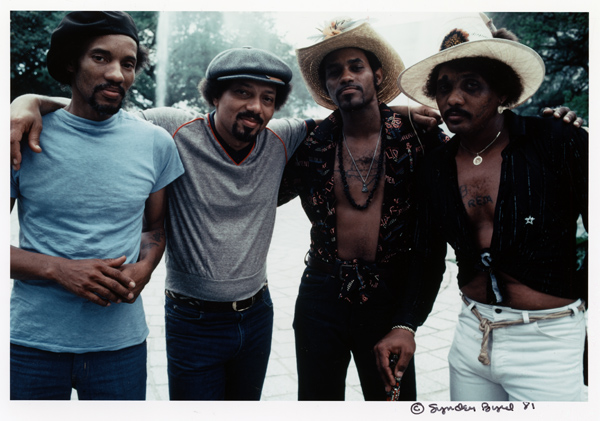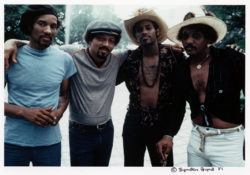Neville Brothers
Art, Aaron, Charles, and Cyril Neville comprise one of the most successful groups to emerge from New Orleans in recent decades; among many other projects, this family of musicians has performed and recorded as "The Neville Brothers" since 1977.

LOUISIANA STATE MUSEUM
The Neville Brothers, 1981.
Art, Aaron, Charles, and Cyril Neville comprise one of the most successful musical groups to emerge from New Orleans in recent decades; among many other projects, this family of musicians has performed and recorded as “The Neville Brothers” since 1977. The Nevilles have made substantial contributions across several genres of US popular music, including rhythm and blues (R&B), jazz, and soul. Drawing inspiration from the music of New Orleans carnival and parade traditions, they played an instrumental role in defining the funk sound from the 1970s onward.
Early years
Art (b. 1937), Charles (b. 1938), and Aaron (b. 1941) grew up in the city’s Thirteenth Ward and later the Calliope housing projects, in a family that loved music. Their mother, Amelia, danced in a team act with her younger brother George Landry, a gifted piano player known to his nephews by the nickname “Uncle Jolly.” Their father, Arthur, worked as a Pullman porter and, like Landry, a merchant seaman. Although he did not play, he had a keen interest in music and counted singer-guitarist Smiley Lewis among his friends. Art soon learned to play barrelhouse-style piano, while Charles picked up the tenor saxophone. Although he did not study an instrument, Aaron began developing his singing skills early on, practicing doo-wop songs with Art and neighborhood friends and exploring gospel music.
Six years after the birth of his youngest brother Cyril in 1948, Art began to make his first forays into the music business. In 1954 he and his group the Hawketts recorded “Mardi Gras Mambo,” which was released by Chicago, Illinois-based Chess Records. The infectious song soon became a Carnival standard, although the performers saw none of the profits. Art began to develop his career as a solo artist and released several singles on the Specialty label, based in Los Angeles, California. He moved to Instant in 1962 where he had a local hit with the ballad “All These Things.”
Charles and Aaron likewise began their careers performing as members of the Hawketts. Charles left school at age fifteen to play in touring R&B bands including Gene Franklin’s House Rockers and the Rabbit’s Foot Minstrel Show. In 1960 Aaron began recording as a solo artist for Allen Toussaint‘s Minit label. Aaron was working as a stevedore, however, when he scored his biggest hit to date in 1966 with the ballad “Tell It like It Is,” which showcased his impressive falsetto range. Released on a new local label, Par-Lo, the song spent more than four months on the Billboard R&B charts, peaking at number one. While the single boosted Aaron’s recording career, its sudden success proved too much for the small record label, which soon folded. Meanwhile, Aaron toured the country, backed by his brother Art and other New Orleans musicians.
In the late 1960s, Art formed The Neville Sounds, a group that included Aaron and Cyril, and played regularly at the Nite Cap. In 1967 Art pared down the band to a sparse but capable quartet of bass, drums, guitar, and Hammond B-3 organ; the group became known as The Meters. Aaron, Cyril, and other remaining family members formed another band, the Soul Machine. Charles’s promising career was interrupted by a conviction on marijuana possession charges; he spent a three-year prison term in Angola Penitentiary. Upon his release, he moved to New York City, where he played with groups including Tony Ferrar and the Band of Gold as well as a trio with brothers Cyril and Aaron.
New Orleans’s first family of funk
In his retirement, George “Uncle Jolly” Landry became active with the Mardi Gras Indians of New Orleans, founding the Wild Tchoupitoulas tribe. He and the four Neville brothers, joined by members of The Meters, recorded the album Wild Tchoupitoulas in 1976, a project produced by Allen Toussaint and released on Island Records. The album, which drew heavily on the distinctive chants and rhythms of the Indians, marked a transitional moment in the brothers’ careers. Following this release, their music increasingly relied upon and reinterpreted musical ideas and techniques drawn from New Orleans carnival and parade customs. In 1977 they made their debut at Tipitina’s as The Neville Brothers, with Art, Charles, Aaron, and Cyril joined by nine other musicians, all of them from the Thirteenth Ward. They built a reputation for their live shows through performances in New Orleans clubs and on the road, in shows that included a four-year stint opening for the Grateful Dead during the late 1970s.
In 1978 Capitol Records released their debut album, The Neville Brothers, but failed to promote the group with a tour. They soon signed with A&M, which released Fiyo on the Bayou in 1981, featuring several Mardi Gras Indian standards and a Louis Armstrong cover. Studio albums failed to capture the energy of their celebrated live shows, which was documented on the 1984 release Neville-ization, recorded live in Tipitina’s. They won a Grammy for the song “Healing Chant,” included on their 1989 album Yellow Moon, produced by Daniel Lanois. The Neville Brothers continued to release records with A&M for the next decade. In the late 1990s the brothers signed with Columbia, releasing Valence Street in 1999, a tribute to the Thirteenth Ward neighborhood where they still resided. In 2004, they released Walkin’ through the Shadow of Life on EMI. Since then, the group has pursued independent distribution.
In addition to their collective efforts, all the brothers have been prolific as collaborators and solo artists throughout the past four decades. Aaron Neville has enjoyed four gold and three platinum-selling albums as a soloist, crossing genre boundaries to record duets with country stars including Trisha Yearwood, with whom he won a Grammy; he also has recorded several albums of sacred music. Charles has toured with a long list of jazz, blues, and R&B stars. Art has appeared on albums by Paul McCartney and Dr. John, while Cyril formed the Wetlands All Stars with other New Orleans musicians. For many years, the Neville Brothers set served as the grand finale of The New Orleans Jazz & Heritage Festival.
